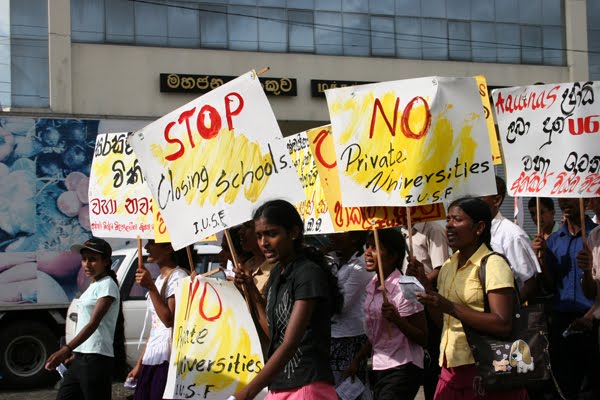By Professor Vijaya Kumar -
Sri Lanka is proud of its free education system but the system is not without problems. Wide disparities in quality make parents clamour for admission to the well-known national schools to ensure better opportunities for their children. This has led to both widespread corruption in admission at primary level and the development of a parallel unregulated education system in the form of “international” schools outside the national education system. Although students could theoretically move into better schools through the Year 5 examination, this is near impossible from rural schools. The failure of the secondary school system is shown by the fact that 50% of students sitting the O/L examination fail in Mathematics, blocking all avenues of decent employment. Although governments pays lip-service to the need for English, IT knowledge and science, most rural schools do not have competent staff and many are even without electricity connections.

It is generally accepted that private universities have helped improve education in developed countries like the United States. What is not often emphasized is that most of them are “not for profit” Universities
Although the enrolment rate in primary school in Sri Lanka is extremely high at 99.7%, tertiary enrolment at 4% places Sri Lanka in the world’s bottom 15. The benefits of education for the country’s workforce are therefore mixed. The average Sri Lankan would have three years of secondary education, but less than three months of tertiary education placing the country in the world’s top 30 and bottom 20 in these categories. This is not surprising as there is only space in the state Universities to accommodate 15% of those qualifying each year. The GCE (A/L) examination is therefore very competitive and admission to professional courses is biased towards the urban elite and rich students who have access to expensive tuition, making a mockery of “free” education. While the district quota system aims to correct this bias, it is only able to make a small dent to the injustice in the system as it favours provincial elites over the rural poor.
Sri Lanka has failed to invest adequately on education with public expenditure on education being slightly less than the 2.4% of GDP spent by Bangladesh and the 3.1% by India and much less than the 4.3% spent by Thailand and 7% spent by Malaysia. The problem is made even more acute because while most of these countries make in addition substantial private investments in education, Sri Lanka’s policy has been to discourage private investment in education.
Government should be urged to greatly increase its investment in education. It was encouraging to note that one of the demands during the recent University pay dispute was to increase investment in education to 6% of GDP. At primary and secondary levels, there must be a serious attempt to substantially improve schools catering to the needs of the rural poor and address imbalances in human resources by substantially increasing salaries and privileges of teachers willing to work in these difficult areas. There is no other way of improving access to Mathematics, English and IT training in the rural sector, although this may be resisted by the highly politicized largely incompetent educational system.
Having failed to invest in education, the government is now pointing to deficiencies in the sector to emphasize the need to promote private investment in education. Issues concerning the South Asia Institute of Technology and Medicine, a rather odd name for a private medical university highlight the problems many of our neighbours have had to face when opening up the field to private education. While agreeing that the introduction of private sector education may provide enhanced opportunities for Sri Lankan children in tertiary education, there are many reasons to believe that the present strategy will fail, simply because there is no mechanism in place to ensure quality, proper admission procedures and reasonable fees. It is always difficult to ensure fairness in private education. Strategies include providing a third of the places on scholarship by increasing fees by 50% and fairer systems of admission for both categories which rely exclusively on the A/L merit list have rarely succeeded.
It is generally accepted that private universities have helped improve education in developed countries like the United States. What is not often emphasized is that most of them are “not for profit” Universities which have become prestigious because all profits are used to improve the University, unlike the highly profitable business ventures masquerading as educational initiatives in Sri Lanka both at international school and tertiary education level. Although India has seen big business houses like Tata and Birla establishing research institutions and postgraduate Universities run by the state sector with minimum interference, we are yet to see similar initiatives in Sri Lanka.
The sad experience in our region has been that very few private Universities initiate courses other than in the highly profitable fields of medicine, information technology and business studies although national development strategies require investment in engineering and science. Many issues should be sorted out before initiating a pro-private education policy and before that it is vital for government to convince people that it is truly interested in improving education in the country by enhancing investment in the state sector and correcting the present injustice in the system.
*Vijaya Kumar is senior Professor of chemistry at the University of Peradeniya, Sri Lanka. He also a senior member of the Lanka Sama Samaja Party. This article provided by Anik Pituwa , the left platform.


No comments:
Post a Comment